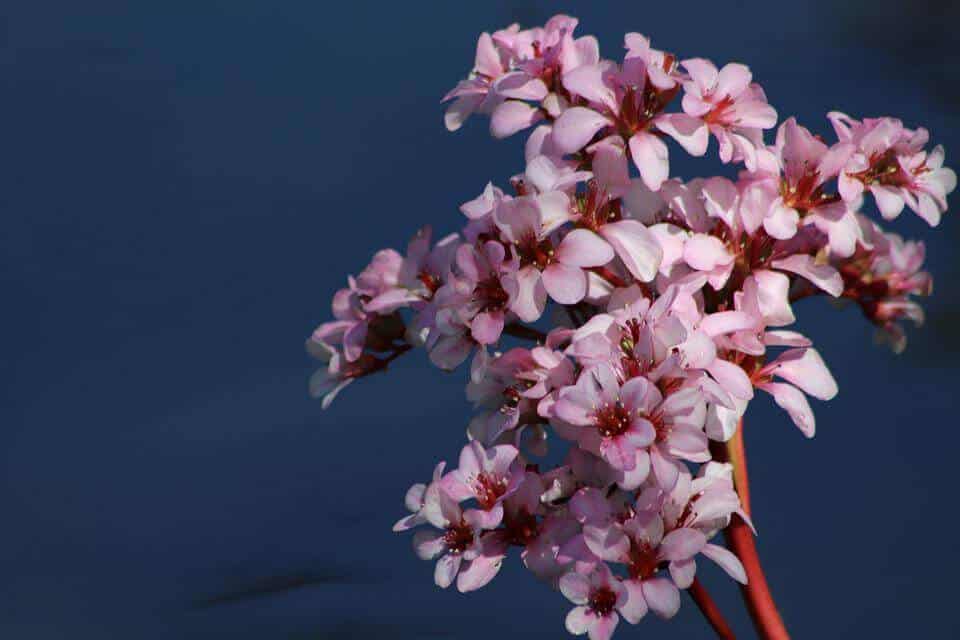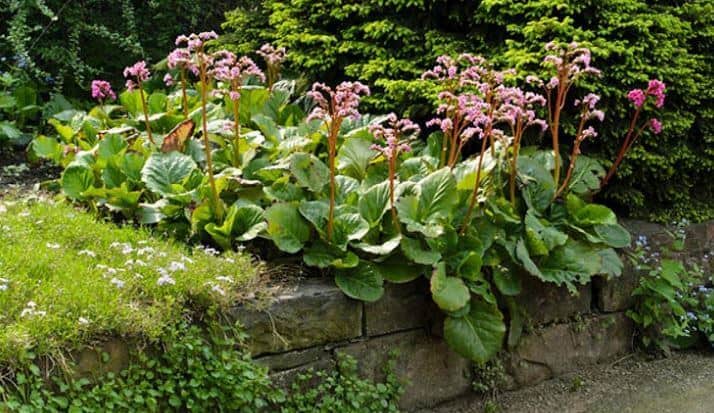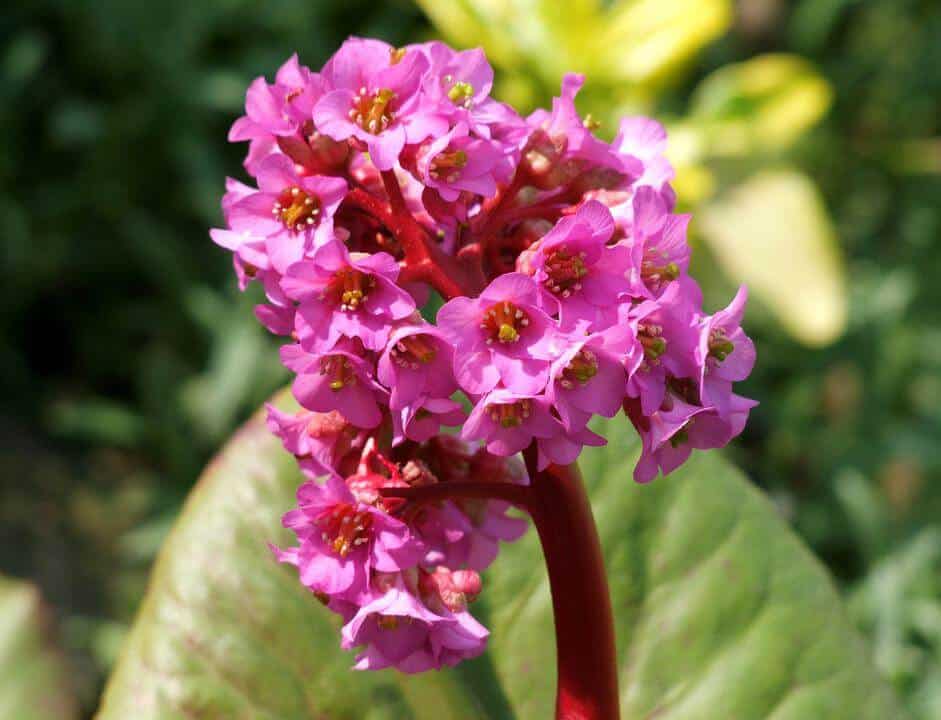Last Updated on January 11, 2023 by a Friendly Gardener
If you are looking for a plant that would make a gorgeous ground cover in the shady regions of your garden, Bergenia crassifolia would make an excellent choice. The large lavender-pink flowers and thick glossy leaves of Bergenia crassifolia would be a beautiful sight to look at.
The Bergenia crassifolia plant has evergreen foliage and is commonly known by the name Siberian tea. Bergenia crassifolia is native to rock cliffs from China to Siberia. Though evergreen, their leaves could become brown in winter.
Growing Bergenia Crassifolia from Seeds

Though they would make excellent ground covers for your garden, the Bergenia crassifolia plant could be slow to spread. Growing Bergenia is considered a simple process and the easiest way to propagate or grow Bergenia is by starting seeds indoors. Let’s have a look at the different steps to be taken to grow Bergenia crassifolia from seeds.
Starting Seeds Indoors
The major advantage of starting your seeds indoors is that you can have control over the conditions that aid in the germination process. The planting tray for Bergenia crassifolia seeds should be made at least four weeks before the last frost of the season.
Bergenia crassifolia seeds require high temperatures and plenty of light for germination to take place. You can use a heating mat to provide it with warm temperatures in the range of 70 to 75 degrees Fahrenheit and keep them near a window sill that gets enough sunlight.
Once the germination has taken place, it’s time for them to be moved outdoors to your garden. Make sure that the seedlings are removed with extreme care, without causing any damage to their roots.
Planting the Seedlings

If the seedlings have developed big root balls, ensure that you dig a large enough planting hole to contain them properly. The seedlings could be planted in an area that receives plenty of sunlight or in a fully or partially shaded area. Bergenia can grow regardless of whether they are kept in sun and shade.
Make sure to amend the native soil of your garden with organic matter and compost before the seedlings are planted. Bergenia crassifolia would grow well when planted in loamy soil rich with nutrients and organic matter.
After readying the soil, you can sow the seedlings by keeping them at least 12 to 18 inches apart to prevent overcrowding. Water immediately once you are done with sowing.
Bergenia Crassifolia Care

The Bergenia crassifolia plant is known to be a hardy plant that can tolerate temperature extremes. They are also drought resistant. In short, caring for Bergenia crassifolia requires very less maintenance. You mustn’t neglect these plants as they require only a little care.
Let’s have a look at the different ways in which you could care for your Bergenia crassifolia.
Soil
Bergenia crassifolia would grow quite nicely when planted in well-draining and aerated soil that is rich in organic matter.
Water
With Bergenia, you don’t need to worry about the plants dying if you don’t water them regularly. Though the Bergenia crassifolia plant grows well in moist soil, they are drought tolerant.
Temperature
The Bergenia crassifolia plant is quite hardy and tolerates extreme temperatures from -20 degrees to 115 degrees Fahrenheit. Though they can bloom even when kept in shade, make sure that they get some amount of light too.
Mulching
Bergenia would thrive when provided with enough moisture, and mulching is the best way to retain moisture without overwatering the plants. You can make a thick layer of mulch to keep your plant moist. Compost or manure would also help in retaining soil moisture.
Look Out for Diseases
Bergenia is susceptible to developing spots on the leaves. Leaf spots in Bergenia crassifolia are generally a sign of poor air circulation or underwatering. Make sure that the plants aren’t overcrowded, and if they are, remove some plants to another location.
Dividing the Plants
It’s important to dig up your Bergenia crassifolia plant every few years to keep them healthy. As time passes, your bergenia might wither and wilt. Dividing the stems and replanting them could help the bergenias retain their strength.
Watch Out for Pest Attacks
Though Bergenia crassifolia is resistant to the attacks of many varieties of pests, they are at risk of the attacks of a pest called root weevil which could eat the thick leaves of Bergenia crassifolia. It’s best to use an organic pesticide if you want to ward off the attacks of root weevils.
It’s also necessary to deadhead the flowers once they’ve started fading or withering. Make sure to remove old leaves as they could attract snails which may cause damage to your plant.
Uses of Bergenia Crassifolia

Bergenia crassifolia has uses other than being an ornamental plant. Let’s have a look at the different uses of Bergenia crassifolia.
Flower Arrangements
The colorful blooms of Bergenia crassifolia in the shade of lavender-pink and the bright glossy leaves make an excellent choice for flower arrangements.
Border Plant
The short length and the quality to bloom in shade and sun alike make Bergenia crassifolia a great choice as bordering plants for your garden. Bergenia crassifolia plants are also resistant to the attacks of rabbits and deers.
Edible Uses
The common name ‘Siberian tea’ of Bergenia crassifolia is derived from its use as a tea substitute. The old blackened leaves that have survived winters are edible and are generally used as tea substitutes.
Medicinal Uses
Bergenia has been widely used as a popular medicinal remedy in different parts of China, Russia, and Mongolia. The leaves and roots of the Bergenia crassifolia plant are known for their anti-inflammatory properties, antimicrobial, antiobesity, and antihypertensive properties.
The parts of the plant are also used for treating diseases like typhoid, diarrhea, intestinal disorders, etc.
Parting Thoughts
Bergenia crassifolia is perhaps the most popular and prominent species of the genus Bergenia. Known for their ability to withstand extreme temperatures and drought tolerance, they could make your garden vibrant with their blooms. Ensure that you take care of these plants well by providing them with suitable growth conditions.

